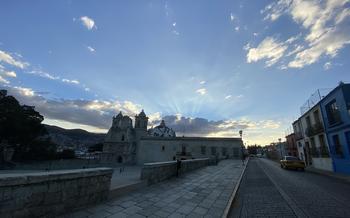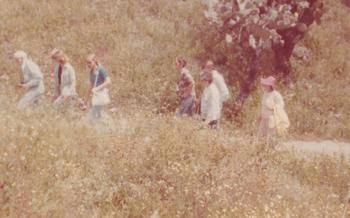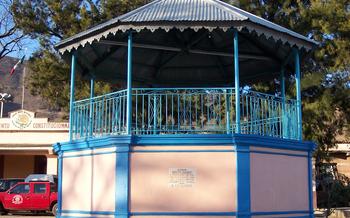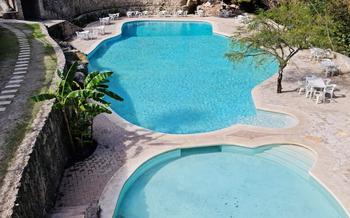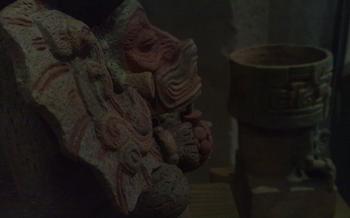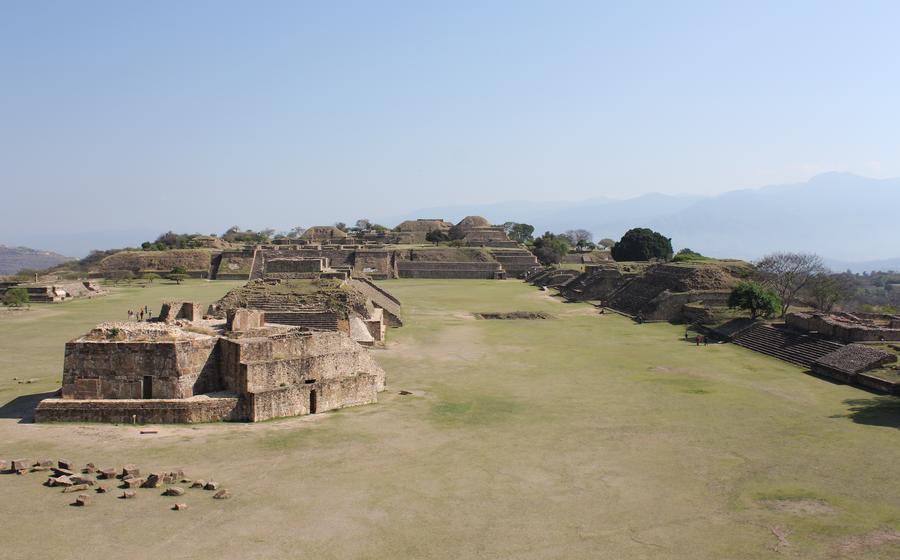
Atzompa Archaeological Site
- Atzompa Archaeological Site: An Overview
- Unveiling the Zapotec Heritage
- Exploring the Pyramid of the Dancers
- The Ball Court and Rituals
- The Tombs and Burial Practices
- The Museum of Atzompa
- Local Artisans and Crafts
- Culinary Delights of Atzompa
- Community Engagement and Interactions
- Natural Beauty and Surroundings
- Cultural Festivals and Celebrations
- Accommodation and Lodging Options
- Transportation and Getting Around
- Safety and Precautions
- Insider Tip: Unveiling the Secrets of the Ancient Zapotecs
Atzompa Archaeological Site: An Overview
Nestled in the picturesque Valley of Oaxaca, the ancient Zapotec city of Atzompa stands as a testament to the rich cultural heritage of Mexico. With its intriguing ruins, awe-inspiring architecture, and significant archaeological discoveries, Atzompa offers a captivating glimpse into the lives of one of Mesoamerica's most advanced civilizations.
Conveniently located just a short distance from the city of Oaxaca, the Atzompa Archaeological Site is easily accessible by car or public transportation. Whether you're a history buff, an architecture enthusiast, or simply seeking an off-the-beaten-track adventure, Atzompa promises an unforgettable experience.
Plan your visit during the dry season, which runs from November to April, to enjoy the most favorable weather conditions and avoid the crowds. The site is generally open from 8 am to 5 pm, with an entrance fee that provides access to all the ruins and the on-site museum. Allow at least two to three hours to fully explore the site and immerse yourself in its captivating history.
Unveiling the Zapotec Heritage
Atzompa holds immense significance as a ceremonial center of the ancient Zapotec civilization. This vibrant and sophisticated culture flourished in the Oaxaca Valley from around 700 BC to 1521 AD, leaving behind a rich legacy of art, architecture, and rituals.
The Zapotecs were skilled builders, and Atzompa showcases their architectural prowess. The site features several impressive structures, including the Pyramid of the Dancers, the ball court, and various tombs. These structures demonstrate the Zapotecs' mastery of engineering and their deep understanding of astronomy and mathematics.
One of the most striking features of Atzompa is its intricate carvings and bas-reliefs. These artworks depict scenes from Zapotec mythology, history, and everyday life. They offer valuable insights into the Zapotec worldview and their beliefs about the cosmos, the gods, and the afterlife.
The artifacts discovered at Atzompa, such as ceramics, figurines, and jewelry, further illuminate Zapotec culture. These objects showcase the Zapotecs' artistic skills, their sophisticated craftsmanship, and their unique aesthetic sensibilities. They also shed light on Zapotec trade networks and their interactions with other Mesoamerican civilizations.
Exploring Atzompa is a journey into the heart of Zapotec civilization. It is an opportunity to witness the grandeur of their architecture, marvel at their artistic achievements, and gain a deeper understanding of their complex and fascinating culture.
Exploring the Pyramid of the Dancers
At the heart of the Atzompa Archaeological Site lies the enigmatic Pyramid of the Dancers, a testament to the Zapotec civilization's architectural prowess and religious beliefs. This majestic pyramid, named after the intricate carvings of dancing figures adorning its facade, is a must-see for any visitor to Atzompa.
Constructed atop a natural hill, the Pyramid of the Dancers rises imposingly, its four sides adorned with steep staircases that beckon visitors to climb to its summit. The structure's design is a marvel of engineering, showcasing the Zapotecs' mastery of construction techniques. The pyramid's base is a perfect square, measuring approximately 20 meters on each side, and its height reaches an impressive 15 meters.
The intricate carvings that give the pyramid its name are a true highlight of the site. These bas-reliefs depict various scenes, including dancing figures, musicians, and processions, offering a glimpse into the Zapotec culture's rituals and ceremonies. The dancers are depicted in various poses, their arms and legs moving rhythmically, as if caught in a moment of joyous celebration.
Legends and anecdotes surrounding the Pyramid of the Dancers abound, adding to its mystique. One tale speaks of a group of Zapotec dancers who, upon completing a sacred ritual, were transformed into stone by the gods, forever immortalized in the pyramid's carvings. Another legend tells of a hidden chamber beneath the pyramid, where treasures and artifacts of immense value are concealed, waiting to be discovered by a worthy explorer.
As you stand before the Pyramid of the Dancers, let your imagination soar as you contemplate the ancient Zapotec civilization and the stories that these enigmatic carvings hold. The pyramid stands as a testament to their artistry, their religious beliefs, and their enduring legacy in the land of Oaxaca.
The Ball Court and Rituals
At the heart of Atzompa's ceremonial center lies an impressive ball court, a testament to the ancient Mesoamerican obsession with the ritual ball game. This elongated, I-shaped court, measuring approximately 60 meters in length, is a remarkable example of Zapotec engineering and artistry. The sloping sides, meticulously crafted from stone, provided ample seating for spectators who gathered to witness the thrilling matches.
The ball game, known as tlachtli, was not merely a sport but a sacred ritual deeply intertwined with Zapotec religious beliefs and cosmology. It was believed that the outcome of the game had a profound impact on the fertility of the land, the success of the harvest, and the well-being of the community. The players, often adorned in elaborate costumes and protective gear, represented opposing forces in a symbolic battle that mirrored the cosmic struggle between light and darkness, good and evil.
Beyond its religious significance, the ball game also held social and political importance. It served as a platform for resolving conflicts, forging alliances, and demonstrating prowess and prestige. The victors were celebrated as heroes and honored with lavish ceremonies, while the losers faced consequences that could range from shame and ridicule to ritual sacrifice.
The ball court at Atzompa is not just a physical structure but a window into the rich cultural and spiritual world of the ancient Zapotecs. It invites visitors to contemplate the deep symbolism and profound rituals that surrounded this ancient game, offering a glimpse into a civilization that revered the sacred and celebrated life's interconnectedness.
The Tombs and Burial Practices
Atzompa's ancient Zapotec inhabitants left behind a fascinating legacy of burial practices and elaborate tombs. The site boasts several types of tombs, each offering a glimpse into the Zapotec reverence for their deceased.
One can explore chamber tombs, which feature a central chamber surrounded by smaller niches for additional burials. These tombs often contained multiple individuals, suggesting a communal or family burial tradition. Elaborate shaft tombs, with deep vertical shafts leading to underground chambers, are another notable feature of Atzompa. These tombs were likely reserved for high-ranking individuals or rulers, as evidenced by the rich grave goods discovered within them.
Excavations at Atzompa have unearthed a wealth of artifacts from within these tombs, shedding light on Zapotec beliefs and rituals surrounding death. Ceramic vessels, often adorned with intricate designs, are commonly found in tombs, serving as offerings to accompany the deceased on their journey to the afterlife. Jade and obsidian ornaments, as well as precious metal jewelry, were also placed in tombs as symbols of status and wealth. These artifacts provide valuable clues about Zapotec social hierarchy and craftsmanship.
Exploring the tombs of Atzompa is an awe-inspiring experience, offering a tangible connection to the ancient Zapotec civilization. Visitors can gain a deeper understanding of their burial customs, beliefs in the afterlife, and the profound reverence they held for their ancestors.
The Museum of Atzompa
The Museum of Atzompa, nestled in the heart of the town, serves as a repository of Zapotec history and cultural heritage. Within its adobe walls, visitors embark on a journey through time, exploring the rich legacy of the Zapotec civilization. The museum's collection boasts an array of artifacts, including intricate ceramics, finely crafted figurines, and exquisite jewelry, each piece narrating a chapter in the Zapotec story.
Among the highlights of the museum's collection are the intricately painted urns, adorned with Zapotec symbols and iconography. These vessels, once used for funerary purposes, offer a glimpse into the spiritual beliefs and practices of the ancient Zapotecs. The museum also houses a remarkable collection of stone sculptures, including stelae and bas-reliefs, which depict scenes from Zapotec mythology and history.
The Museum of Atzompa plays a pivotal role in preserving and promoting Zapotec cultural heritage. Through its exhibits and educational programs, the museum strives to foster a deeper understanding and appreciation of the Zapotec legacy among visitors and locals alike. A visit to the museum is an essential experience for anyone seeking to delve into the heart of Zapotec culture and gain a profound understanding of this ancient civilization.
Local Artisans and Crafts
Atzompa is renowned for its thriving artisan community, where the Zapotec people have preserved their ancestral skills and traditions. Visitors can immerse themselves in the vibrant world of Zapotec crafts, which include pottery, weaving, and wood carving. The town is a treasure trove of handmade souvenirs, from intricate clay figurines to colorful woven textiles.
One can witness the artisans meticulously crafting their masterpieces in their workshops, using techniques passed down through generations. The potters skillfully shape clay into various forms, creating functional and decorative pieces. The weavers create vibrant tapestries and intricate textiles using traditional backstrap looms. The wood carvers transform ordinary pieces of wood into intricate sculptures and decorative items.
Visitors have the opportunity to interact with the artisans, learn about their creative process, and purchase unique souvenirs directly from the source. This interaction provides a glimpse into the cultural heritage of Atzompa and supports the local economy. Whether you're looking for a one-of-a-kind piece of pottery, a colorful textile, or a beautifully carved wooden figurine, Atzompa's artisans have something special to offer.
Culinary Delights of Atzompa
The cuisine of Atzompa is a testament to the town's rich Zapotec heritage, blending traditional flavors with modern culinary influences. Visitors to Atzompa can indulge in a variety of mouthwatering dishes, each infused with the unique flavors of the region.
A must-try dish is tlayudas, large, crispy tortillas topped with a variety of ingredients such as beans, cheese, meat, and vegetables. Another local specialty is tamales, savory corn cakes filled with meats, cheeses, or vegetables, wrapped in banana leaves and steamed to perfection.
For a taste of the local seafood, try the freshly caught fish, grilled or fried, and served with a tangy salsa. Local markets offer a vibrant array of fresh fruits, vegetables, and spices, allowing visitors to create their own culinary creations.
Local restaurants serve traditional Oaxacan dishes with a modern twist, offering a unique dining experience. Be sure to try the mezcal, a smoky, traditional spirit made from roasted agave, which is produced in the surrounding region.
Personal Experience:
During my visit to Atzompa, I had the pleasure of dining at a local restaurant that served traditional Zapotec cuisine. The tlayudas were particularly delicious, with a crispy tortilla topped with a generous amount of beans, cheese, and shredded chicken. The mezcal was also a highlight, offering a smooth, smoky flavor that complemented the food perfectly.
Community Engagement and Interactions
Atzompa's people are renowned for their inviting and friendly nature, going above and beyond to welcome tourists and share their rich cultural heritage. Immerse yourself in the vibrant Zapotec culture by engaging with locals through cultural events, workshops, or guided tours. These interactions provide a unique opportunity to gain insights into Zapotec traditions, customs, and daily life.
One unforgettable experience is attending a traditional Zapotec weaving workshop. Watch skilled artisans transform vibrant threads into intricate patterns, breathing life into beautiful textiles. Learn about the symbolism and techniques passed down through generations, and perhaps even try your hand at creating your own Zapotec masterpiece.
Join the locals for a lively celebration during one of Atzompa's many festivals, such as the Guelaguetza or the Day of the Dead. These vibrant events showcase traditional music, dance, and cuisine, allowing you to experience the heart and soul of Zapotec culture firsthand.
Whether you're chatting with friendly vendors at the local market, learning to cook traditional Zapotec dishes with a local family, or simply exchanging smiles and greetings with passersby, the warmth and hospitality of the Atzompa people will leave a lasting impression. Embrace the opportunity to connect with this welcoming community and create memories that will stay with you long after you leave.
Natural Beauty and Surroundings
Atzompa's natural beauty is as captivating as its cultural heritage. Nestled amidst the rolling hills of the Sierra Madre del Sur, the town offers breathtaking views and a diverse range of outdoor activities. Hiking enthusiasts can embark on scenic trails that wind through lush forests and lead to hidden waterfalls or panoramic viewpoints. For those seeking a more leisurely experience, nature walks through the surrounding valleys provide an opportunity to admire the local flora and fauna. Bird watching enthusiasts will delight in the diverse avian population, including colorful parrots, hummingbirds, and eagles that soar above the treetops. Photography enthusiasts can capture stunning images of the region's natural wonders, from vibrant wildflowers to dramatic rock formations. Whether you're an avid hiker, a nature lover, or simply seeking a tranquil escape, Atzompa's natural beauty promises an unforgettable experience.
Cultural Festivals and Celebrations
Atzompa comes alive during its vibrant cultural festivals and events, showcasing the rich heritage and traditions of the Zapotec people. The most famous of these is the Guelaguetza, held annually in July. This colorful festival features traditional music, dance, and parades, as well as a lively market where visitors can purchase handmade crafts and sample local delicacies.
Another significant celebration is the Day of the Dead, observed in early November. During this time, families honor their deceased loved ones by building elaborate altars adorned with flowers, candles, and offerings. Visitors can witness this moving tradition and gain insights into Zapotec beliefs about life and death.
To fully immerse yourself in the festive spirit of Atzompa, plan your visit to coincide with one of these cultural events. You'll have the opportunity to witness the vibrant expressions of Zapotec culture, connect with the local community, and create memories that will last a lifetime.
Accommodation and Lodging Options
Atzompa offers a range of accommodation options to suit different budgets and preferences. For a truly immersive experience, consider staying in a traditional Zapotec homestay, where you can interact with local families and learn about their daily lives. These homestays often provide simple but comfortable rooms and a chance to sample delicious home-cooked meals.
For those seeking a more luxurious stay, several charming hotels and lodges are located near the archaeological site. These establishments offer modern amenities, stunning views of the surrounding mountains, and easy access to the town's attractions.
Budget travelers can find affordable hostels and guesthouses that provide basic but clean accommodations. These options are ideal for backpackers and solo travelers looking for a budget-friendly place to stay.
Whether you choose a homestay, hotel, or hostel, be sure to book your accommodation in advance, especially during peak tourist season. This will ensure you have a comfortable place to rest after a day of exploring the archaeological site and the town.
Transportation and Getting Around
Reaching Atzompa is a breeze, with multiple transportation options at your disposal. Buses depart regularly from Oaxaca City, providing a convenient and affordable way to get there. Once in Atzompa, you can easily explore the town and the archaeological site on foot. The compact size of the town makes it easy to navigate, and most attractions are within walking distance.
For those seeking a more personalized experience, renting a car is a great option. The freedom to explore the surrounding areas at your own pace is liberating, and the drive offers stunning views of the Oaxacan countryside. Alternatively, hiring a guide can be a rewarding choice. These knowledgeable individuals can provide insights into the history and culture of Atzompa, making your visit even more enriching.
Insider Tip: Consider renting a bicycle to explore the town and the nearby countryside. Cycling through the picturesque landscapes offers a unique and eco-friendly way to experience the region's natural beauty.
Safety and Precautions
Atzompa is generally considered a safe destination for travelers. The local community is known for its friendliness and hospitality, and visitors are unlikely to encounter any safety concerns. However, as with any travel destination, it's essential to exercise common sense and take necessary precautions to ensure a safe and enjoyable visit.
Here are a few tips to keep in mind:
- Be aware of your surroundings and avoid walking alone at night, especially in isolated areas.
- Keep your valuables secure, such as your passport, money, and credit cards.
- Be respectful of local customs and traditions, and dress modestly when visiting religious sites or attending cultural events.
- Drink plenty of water to stay hydrated, especially during the hot and humid summer months.
- If you have any health concerns or allergies, be sure to bring the necessary medications and inform your tour guide or hotel staff.
- Learn a few basic Spanish phrases to communicate with locals and ask for directions or assistance if needed.
- In case of an emergency, dial 911 or contact the nearest police station or hospital.
By following these simple precautions, you can ensure a safe and enjoyable visit to Atzompa.
Insider Tip: Unveiling the Secrets of the Ancient Zapotecs
Beyond the main attractions of Atzompa, there's a hidden gem waiting to be discovered: the ancient Zapotec caves. These caves, located in the surrounding mountains, offer a glimpse into the spiritual and ceremonial practices of the Zapotec people. Visitors can explore these caves, adorned with intricate carvings and pictographs that tell stories of ancient rituals and beliefs. With the help of a local guide, you can delve deep into the history and significance of these sacred spaces, gaining a profound understanding of Zapotec culture. Whether you're a history buff, an adventurer, or simply someone seeking a unique and immersive experience, these caves are a must-visit for anyone exploring Atzompa.

